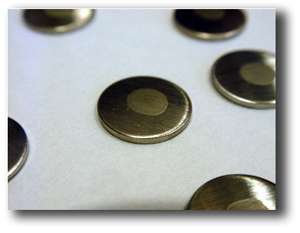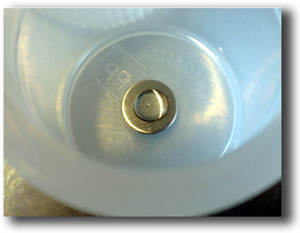ASTM E2197 – Quantitative Disk Carrier Test
Get A Testing Quote
The ASTM E2197 method is designed to test bactericidal, fungicidal, sporicidal, and virucidal capabilities of liquid germicides on non-porous hard surfaces using a 1 cm diameter brushed stainless steel  surface.
surface.
This method has been accepted by the U.S. EPA to substantiate efficacy claims for disinfectants against endospores of Clostridium difficile. The method is being actively developed and refined by the U.S. EPA, particularly with regard to endospore preparation and storage requriements, as well as soil load.
Microchem Laboratory stays abreast of method changes and ensures that clients’ studies benefit from the most current methodology.
Summary of ASTM E2197
- A small volume of test microorganism is added to the center of 1 cm diameter brushed stainless steel disks.
- The test microorganism is dried under vacuum at room temperature.
- After drying, the carriers are individually placed into the bottom of sterile vessels for testing.
- A small volume of test substance is added directly to the center of the carrier (on top of the dried inoculum) and allowed to sit undisturbed for the duration of the exposure period.
- A 10 ml volume of neutralizer/elution media is added to each vessel and vortexed to elute surviving test microorganisms.
- The resulting eluent is serially diluted, and the remaining volume is passed through a membrane filter.
- A series of washes are performed to ensure collection of all surviving test microorganisms as well as removal of any test substance that might interfere with downstream analyses.
- The appropriate dilutions are plated to the appropriate growth agar, and the final rinsed membrane filter is placed directly on the appropriate growth agar.
- A minimum of three inoculated and dried carriers, per test microorganism, are eluted and enumerated to determine the concentration of test microorganism on each carrier.
- Log10 and/or percent reduction calculations are performed for each replicate treated with test substance and when compared to the averaged initial numbers control.
Strengths of ASTM E2197
- ASTM E2197 is a closed test system (no benefit from washing microbes off the carrier), in contrast to methods such as the AOAC Germicidal Spray Test and the AOAC Use-Dilution Test.
- The brushed carrier finish is a good representation of an environmental surface commonly treated with liquid germicides (hospital, kitchen and industrial surface).
- There is reduced test-to-test variability due to method standardization (e.g. test microorganism concentration, inoculation, drying and treatment).
Weaknesses of ASTM E2197
- Germicides that have previously demonstrated border-line “passing” results when tested using traditional methods may have a difficult time passing due to low volumes of test substance and high concentrations of test microorganisms coupled with the lack of agitation, washing, and/or wiping in this method.
- Recent round-robin testing at several laboratories has shown a surprisingly high level of inter-laboratory variability, especially at less-efficacious product concentrations.
If you are interested in setting up a study with the lab, simply contact us or request a price quote.
 Microchem Laboratory has put a great deal of time and thought into perfecting the way we execute this relatively new, quantitative method. If your firm has interest in finding out how existing registered disinfectants will fare in this new method, we encourage you to get in touch.
Microchem Laboratory has put a great deal of time and thought into perfecting the way we execute this relatively new, quantitative method. If your firm has interest in finding out how existing registered disinfectants will fare in this new method, we encourage you to get in touch.
